Conservative treatment of IBC in cats is designed to eliminate the problems by taking medications and a special diet. This is a more gentle method than surgical intervention, but in some cases it may not help.
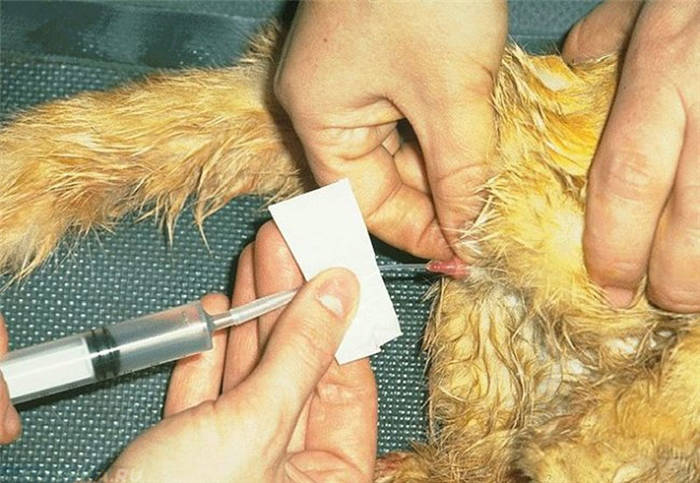
- Urolithiasis in cats – its symptoms and treatment.
- Symptoms of urolithiasis
- Types of food
- The Best Dry Foods for Sick Animals
- Natural nutrition
- What foods can make up a pet's diet
- Forbidden foods
- Specialty foods
- Farmina Vet Life Cat Struvite Management
- Brit Veterinary Diet Cat Grain free Struvite
- Eukanuba Veterinary Diets Urinary Oxalate
- Supplements and vitamin supplements
- Symptoms of urolithiasis in cats
- Treatment of IBC by veterinarians
- What drugs are used
- How to choose a cat food when diagnosed with urolithiasis
- The connection between dry food and urolithiasis – is there any at all
- Conservative treatments
- Surgical methods of treatment
- Surgical options
- Why diet is an important link in the treatment of urolithiasis
- General rules for feeding animals with urolithiasis
- Prognosis of the disease
- Prevention of urolithiasis in cats
Urolithiasis in cats – its symptoms and treatment.
Urolithiasis in cats is accompanied by the appearance of deposits of sand and urinary stones in the area of the kidneys, in the bladder. At the same time, these formations can pass or stagnate in the ureter, urethra, all this may be accompanied by the appearance of blood with the urine. So why is there a buildup of deposits in the kidneys of animals? What might be contributing to it?
Many people think that in cats and cats urolithiasis occurs as a result of excessive consumption of dry food, also, according to them, this ailment can occur in neutered and spayed animals, but this is not true. This disease is provoked by various internal and external factors.
- Improper dietary habits;
- metabolic disorders;
- allergic reactions ;
- Overcooling and overheating of the pet's body;
- sand and stones can manifest with a sedentary life;
- the presence of chronic pathological currents in the kidneys and bladder;
- diseases of the genitourinary system of cats and cats;
- genetic predisposition.
Pay attention! Internal factors in the development of urolithiasis may consist of insufficient fluid intake by the cat. It is necessary to regularly monitor that there is always water in the pet's bowl.
There is a common opinion that dry food contributes to the development of urolithiasis, but statistics show that the disease occurs with the same frequency in animals that constantly use natural food.
The cause of urolithiasis in cats can be feeding cats poor quality food, as well as feeding food from the table – smoked, salty, fried, fatty foods. Genetic factors and hereditary diseases have the greatest influence on the development of this pathological process.
Symptoms of urolithiasis
In the beginning, when the deposits of sand and stones in the kidneys and bladder only begin to appear, it is quite difficult to accurately establish the presence of the disease. But still be sure to watch the condition of the pet, sometimes even at the very beginning you can detect signs of urolithiasis in cats.
After some time, the pet becomes less active, he moves little, also he refuses to eat and he may have a complete loss of appetite. At the same time during urination the animal may have discomfort. The disease has a slow progression and gradually develops into a chronic form.
If the disease progresses to the complicated form, instead of sand there is the formation of stones. At this time there are obvious symptoms of urolithiasis:
- The pet experiences painful sensations while urinating. While on the tray, he meows a lot, the fact is that at this time the stones move and strongly scratch the walls of the urinary tract;
- If you carefully examine the pet's urine, you can find blood spots in it ;
- Cats may sit on the tray frequently because they urinate frequently;
- Sometimes the stone may completely block the urethra, and the cat cannot empty;
- The structure of the abdomen becomes dense and hard. When the cat is palpated, it becomes uncomfortably painful;
- cats often urinate on the surface of upholstered furniture, carpets;
- There may be obvious changes in the cat's behavior. The cat may behave restlessly, constantly drawing attention to himself or, on the contrary, hiding, hiding in corners;
- The cat's breathing becomes more rapid;
- The cat or cat does not eat well or has no appetite;
- increase in temperature to 39-40 degrees ;
- complications manifest themselves with trembling throughout the body, convulsive seizures.
Important! If symptoms similar to IBC in cats appear, it is worth immediately contacting a doctor. The slightest delay can cause serious health complications in the animal.
Types of food
You can feed your pet both natural food (prepared by yourself from approved ingredients) and manufactured food. Dry food with the necessary additives, vitamins and mineral elements is selected only by a veterinarian based on the results of laboratory examination of the animal's urine.
This type of feeding cats with IBC is the most convenient for the owner. The composition of such food is developed in cooperation with nutritionists and veterinarians, taking into account all the nuances of this pathology. Macro- and micronutrients in such feeds prevent the recurrence of stones and contribute to the resorption of existing deposits. Types of dry food:
For feeding pets, the optimal and most appropriate foods are those from the super-premium and holistic categories.
The Best Dry Foods for Sick Animals
Opinions of veterinary experts in this matter are divided, but in general the following brands are considered the best in their category:
- Royal Canin Urinary S/O LP34 – prevents accumulation of sediments in the kidneys, activates the process of urine production. Disadvantages – it is not compatible with many drugs prescribed for the treatment of urolithiasis. Can provoke hypertension in cats.
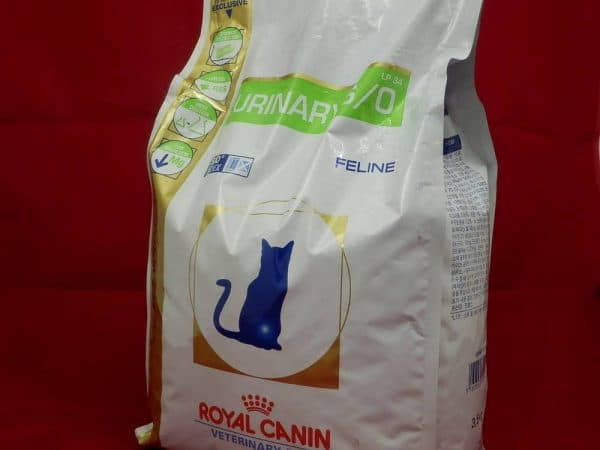
- Hill's – Dissolves stones, prevents the process of excessive calcium accumulation. Contraindications – formation of non-struvite uroliths in the kidneys.
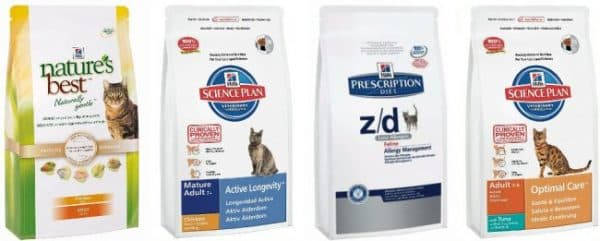
- Eukanuba Urinary Struvite – Increases the concentration of acid in the urine and has a preventive effect by preventing the formation of struvite stones. Contraindication is the presence of oxalate kidney stones.
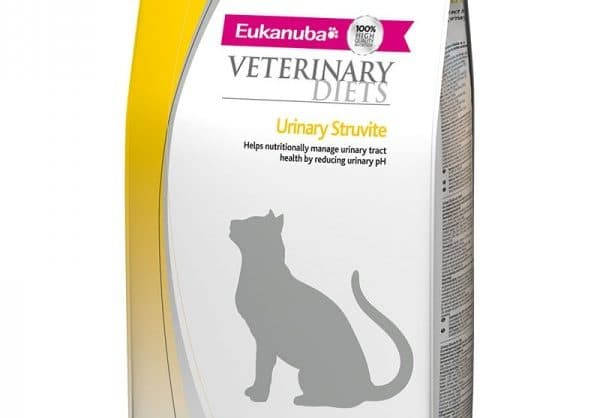
- Purina NF – Contains vitamin D and calcium. Contraindications – weakened pets with critical phosphorus and protein deficiencies.
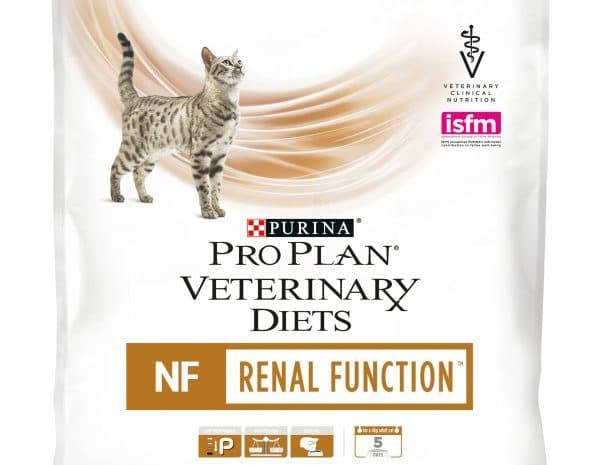
- Purina UR Urinary Feline Formula – Increases acidity of urine and resolves formed struvite crystals.
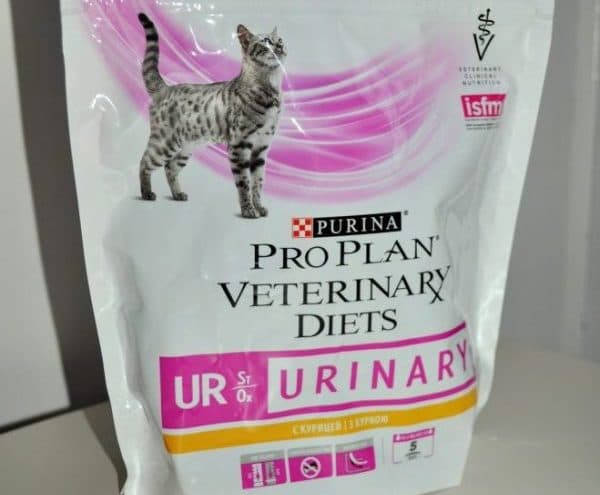
Natural nutrition
Despite the undeniable benefits of specialized ready-made diets, you should not stop giving your pet normal food, because vitamins and minerals should get into the animal's body and with natural products.
The basis of the diet is meat products. Vegetables and fruits should be present in the menu, but in limited quantities and only cooked by boiling. Do not give foods high in calcium and oxalic acid. The diet must be balanced.
What foods can make up a pet's diet
The daily diet is built in such a way that it contains both meat products and vegetables, and specialized food. The menu may include:
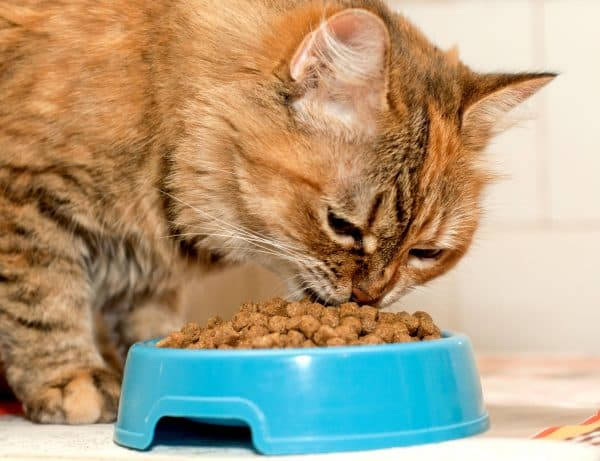
- lean meat varieties – beef, chicken without skin, lamb and veal, it is recommended to give them to the cat only in boiled form;
- Cereals – oats and rice. They are boiled in water without adding salt;
- Vegetables, with preference given to carrots, cauliflower, beets and legumes;
- specialty foods.
Meat is served without broth. It is forbidden to add salt and spices to the dishes.
Forbidden foods
It is forbidden to give the animal dry, non-specialized food. If foods that were previously on the daily menu have become prohibited, the transition to the diet should be made smoothly, to avoid stressing the pet.
Specialty foods
Special therapeutic foods are available for the treatment and nutrition of cats with urolithiasis. They are produced by brands of different price segment from economy class to holistic. But for animals with cystic fibrosis, products of the superpremium or holistic classes are suitable.
Economy segment foods labeled "neutered cats", "cystic fibrosis prevention" are made from low-quality ingredients. Their formula is not balanced, and the harm to the health of even an unhealthy animal is great.
When feeding cats with dry food, it is necessary to strictly observe the daily rate. Its excess leads to overeating, obesity. Overweight and sedentary lifestyle is one of the causes of IBC and cats.
Farmina Vet Life Cat Struvite Management
- Proteins – 33%.
- Lipids – 16,5%.
- Mineral, vitamin supplements (crude ash) – 6,6%
- Fiber – 1,2%
- Phosphorus – 0,7%
- Magnesium – 0, 06%.
- Chlorides – 0.95%.
- Omega-3 fatty acids – 0.40%.
- Omega-6 fatty acids – 3.20%.
Ingredients: corn gluten, rice, freeze-dried chicken meat, oats, animal fats. DL-methionine and ammonium chloride maintain the necessary Ph of the pet's urine, prevent the formation of new concrements.
Pros: Contains glucosaminoglycans to protect bladder mucosa from infections.
Brit Veterinary Diet Cat Grain free Struvite
Ingredients: dehydrated chicken meat, yellow pea protein, chicken protein, buckwheat, green peas.
Pros: Dissolves struvite concrements, prevents new formations. Does not contain grains, does not cause allergies. Suitable for feeding animals with urinary tract infections.
Eukanuba Veterinary Diets Urinary Oxalate
Ingredients: crushed corn kernels, chicken meat, chicken meal, chicken liver, fish meal, dried egg, beet pulp, potassium citrate.
Pros: Dissolves oxalate-type stones, prevents new ones from forming.
Supplements and vitamin supplements
Include vitamin complexes or supplements in the diet of cats with IBC. Before use, a veterinarian should be consulted. The doctor will prescribe the drug, the course of administration.
Supplements are available in the form of tablets or powders. Complexes are also used for the prevention of urolithiasis in castrated cats, animals with kidney failure.
We give a list of popular supplements for cats with urolithiasis:
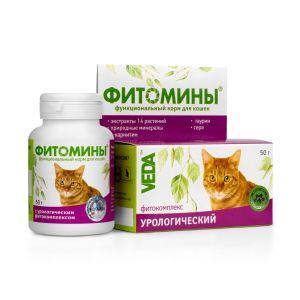
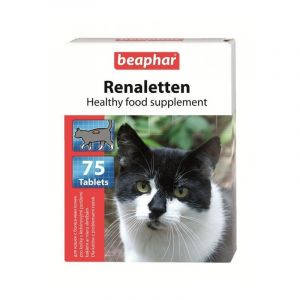
- Steril Cat for the prevention of struvite (manufacturer Unitabs). The drug is approved for use from 8 months of age. It is specially designed for castrated cats at risk. The complex includes: DL-methionine – prevents the formation of phosphorus salts, L-carnitine – prevents the development of obesity, taurine – strengthens the heart muscle.
For cats with IBC it is necessary to make a proper diet. Excessive consumption of foods with fluoride, magnesium, oxalic acid leads to recurrent attacks of urolithiasis. It is important for at least six months after finding kidney stones in the pet to feed him a therapeutic food. This diet helps dissolve the concrements and prevents them from forming.
Published: 2020-02-09
Added: 2021-02-18
Timur Talikbaev
Symptoms of urolithiasis in cats
Problems with the lower part of the excretory system in the earliest stages are manifested in behavioral signs. The cat becomes apathetic, its appetite may change. The more the disease progresses, the more pronounced the symptoms become. In this regard, there are three symptomatic periods: early, acute and critical. In the first stage, when sand and stones are already present in the bladder, cat urolithiasis can be judged by the following signs:
- The pet goes to the toilet more often, sometimes in inappropriate places.
- Urination occurs in a strenuous posture.
- While in the litter tray, the cat meows because of the pain caused by the stones.
- Because of the presence of blood cells, the urine turns pink.
- The cat takes longer than usual to lick itself under the tail.
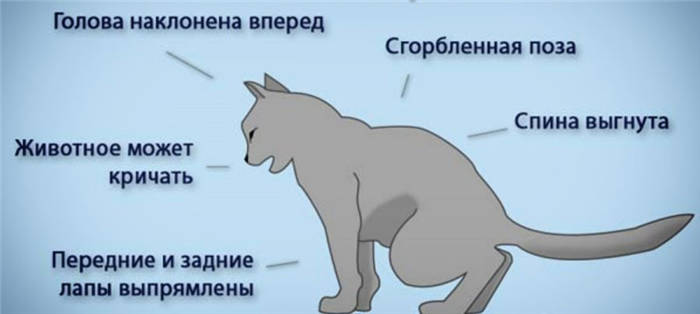
During the severe (acute) stage, these symptoms become even more pronounced and are joined by others. The animal has a small amount of urinary incontinence, and the color of the fluid itself becomes more intense. The urine takes on a specific unpleasant odor. Touching the abdomen causes the cat pain. The body temperature jumps to 39-40 degrees.
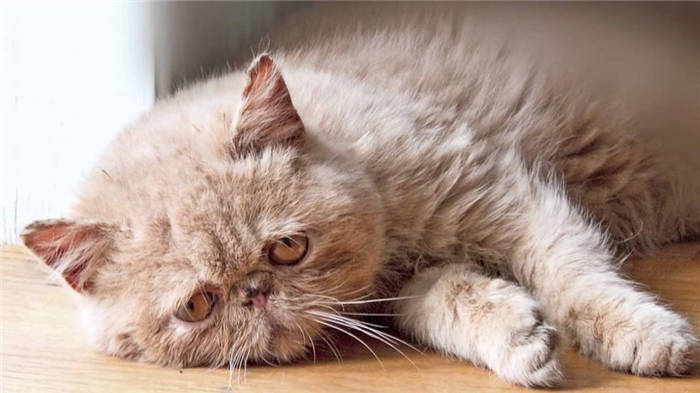
In a critical state, the signs of urolithiasis worsen even more. The pet hardly ever goes to the toilet, and the urges cause severe attacks of pain. Overfilling of the bladder threatens to rupture and peritonitis. Viscous, frothy saliva is secreted from the mouth and vomiting may occur. The temperature drops to 35-36 degrees. Apathy and lethargy are joined by body trembling and convulsions. In the most severe cases, loss of consciousness is possible.
Treatment of IBC by veterinarians
If any symptoms of IBC occur, a veterinarian should be consulted. He will prescribe the necessary diagnostics (ultrasound, X-rays, tests), help empty the bladder and prescribe a treatment course. If no surgical intervention is required, the treatment is conservative in nature and lasts 2-4 weeks. To treat a cat with IBC, it is necessary to:
Urinary bladder disease in cats is treated with human and veterinary medications. The official medications are assisted by phyto-drugs, prepared from herbal medicinal raw materials.
What drugs are used
For pain relief, antispasmodic drugs are used. No-shpa is given to the cat in tablets, Papaverine in addition to the tablet form allows injectable. In some cases, injections with Baralgin are given. But this drug in pain symptoms can provoke bleeding, so it is used much less often. The action of antispasmodics is supported by Prazosin and Terazosin. They help keep the bladder muscles and sphincter relaxed. When the process of urine excretion is stabilized, infusion methods are used. They are aimed at increasing the volume of fluid excreted and relieving intoxication. The cat is prescribed Glutargin with glucose, Vetavit.
If urolithiasis in cats is accompanied by infection, the course of treatment includes antibiotics: Nitroxoline, Furadonin, Enrofloxacin. If blood gets into the urine, connect intramuscular injections with a hemostatic effect: Etamsilat (Ditsinon), Vikasol. As complex medications may be prescribed:
- Stop cystitis
- Uro-ursi
- Urotropin
- Cystocur forte
- Furinaid
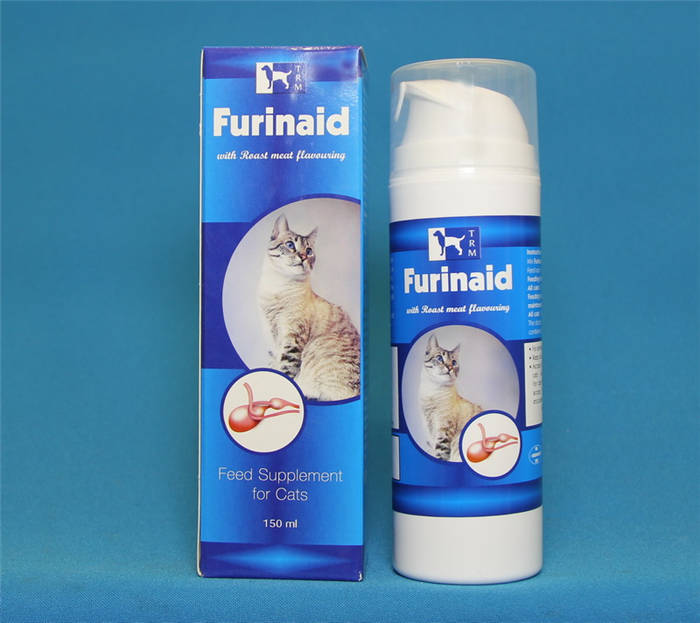
- Ipakitine
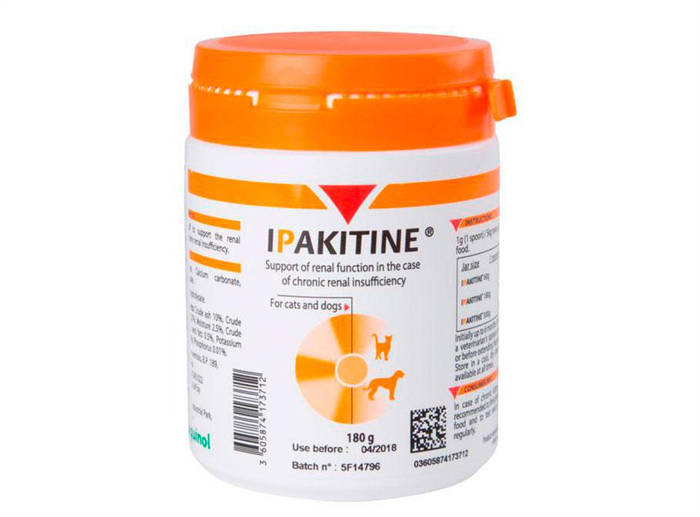
- Cantaren
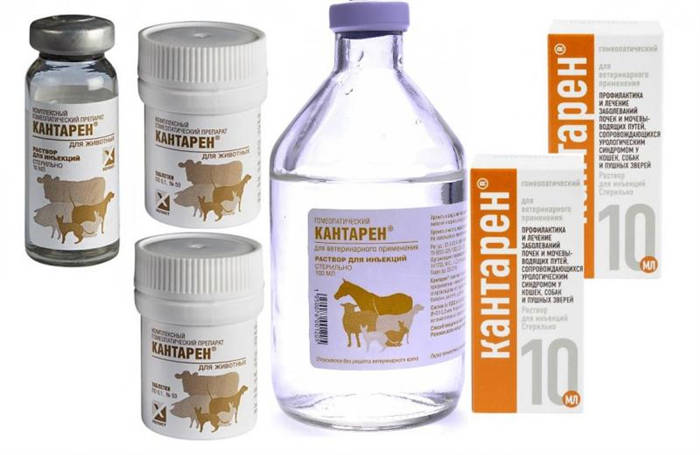
- Nefroket
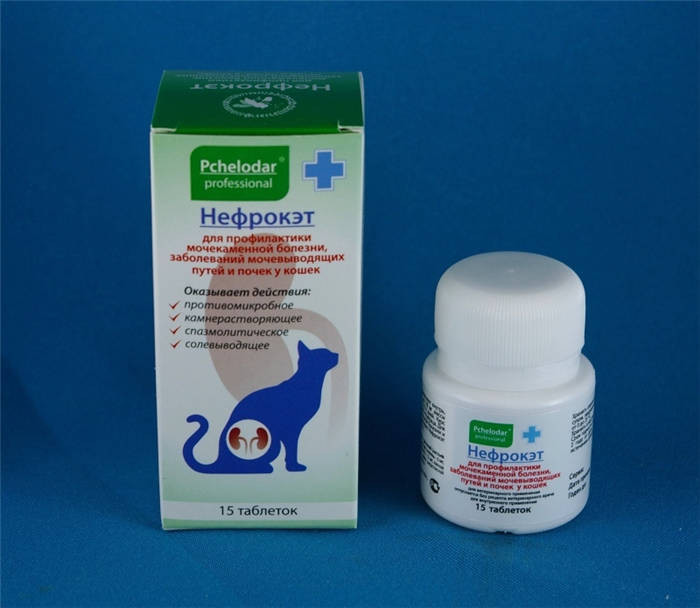
How to choose a cat food when diagnosed with urolithiasis
A therapeutic diet should be chosen carefully after consultation with a specialist.
It is possible to transfer the cat to natural food or choose a high-quality, special food.
Before transferring the cat to a special diet, you should always visit the veterinarian. The specialist will prescribe a number of tests to make an accurate diagnosis. Among the important indicators is a urinalysis. It allows you to identify the type of concrements and subsequently determine the types of products that are allowed or prohibited for the pet.
If there is a high percentage of struvite (alkaline) concrements in the urine, foods or feeds that can acidify the urine should be chosen. This will neutralize the alkaline environment. At the same time there is a decrease in the caloric content of the diet. The fact that urolithiasis with large amounts of struvite in the urine is more often provoked by severe obesity. If fed naturally, foods such as meat, fish, egg whites and beef liver are preferred.
If oxalates (concrements formed in an acidic environment) are found in the urine, foods with an alkalizing effect should be selected. Boiled low-fat meats, cereal porridge, rice, and steamed vegetables are helpful.
Regardless of the type of diet, veterinarians recommend dividing the number of meals into 5-6 meals per day. Portions should not be large. These can be cauliflower, carrots, meat broths, beets, potatoes, lean fish and meat.
Under the ban are such products as milk and cream with a high percentage of fat. It is not recommended to give smoked foods, egg yolks and baked goods to animals. Spicy, salty foods and all kinds of legumes should be excluded from the diet.
Experts point out that it is difficult to properly compose a diet on its own, as well as constantly stick to it. And this, in the case of urolithiasis, can be dangerous for the pet.
The connection between dry food and urolithiasis – is there any at all
The connection between nutrition and the development of urolithiasis is huge, but the connection between dry food and IBS is questionable. Of course, when an animal eats dry food, urolithiasis can develop. But not all foods provoke such changes in the body.
Consumption of cheap feeds that are full of various colorings and preservatives can lead to dangerous changes in the body, including the development of urolithiasis. Statistics show that cats fed with dry cheap food get urolithiasis in 40% of cases, while cats feeding full-balanced high-quality dry food have only 5-6% of the disease incidence.
It is important to choose food based on such parameters as age, activity of the cat and its general state of health.
For example, a 12-month old cat that is constantly inside the apartment should have a different diet than the same cat that has free access to the street. The activity of these animals is completely different, so the consumption of nutrients varies.
The main thing to think about when choosing a pet's diet is the right balance of nutrients.
Conservative treatments
Conservative treatment of urolithiasis is carried out in the initial stages of the disease or in the period of preparation or rehabilitation after surgical intervention.
If the pet owner went to the veterinary clinic at the very beginning of urolithiasis, conservative treatment consists of developing a therapeutic diet and taking supportive medications. The therapy plan is prescribed according to the results of a comprehensive diagnosis. Further treatment tactics depend on the type of urolithiasis: some diets aim to acidify the urine, while others aim to alkalize it.
The standard course of conservative treatment of IBC is as follows:
- Anti-inflammatory drugs (e.g., Furagin, Palin, etc.);
- Antispasmodics (e.g., Baralgin);
- Painkillers (e.g., Papaverine, Analgin);
- Antibiotics (e.g., Ceparin);
- General tonics (e.g., heart and digestive tract medicines and vitamin supplements, if needed);
- Drops to normalize water-salt metabolism (in case of intoxication due to urinary tract obstruction);
- Special diet (as indicated).
Please note: If the exacerbation of urolithiasis is provoked by stress or non-compliance with the veterinarian's instructions, the living conditions of the pet must be reviewed and, if possible, corrected. The process of salt deposition is chronic, so failure to comply with the current scheme of treatment, as well as treatment at half strength, leads to relapses.
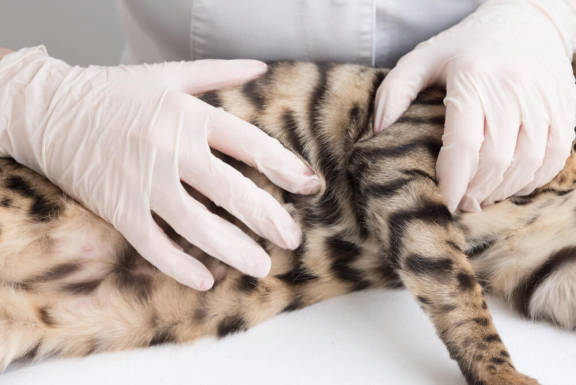
Surgical methods of treatment
If the urinary tracts are blocked, and the veterinarian states the development of acute renal failure, the animal is shown a number of emergency recovery procedures, which may entail surgical intervention.
To free the ducts and restore unimpeded outflow of fluid, the doctor performs a bladder catheterization using local or general anesthesia and flushes the urethral lumen with an antiseptic agent. In some cases, the animal is injected with muscle relaxants, such as the drug Kornam. They relieve urethral spasm, and the cat is able to urinate on its own. If, in addition to urethral spasm, there is inflammation of the canal, this does not happen and the animal is inserted with a catheter or an operation is appointed.
- Blockage (obstruction) of the urethra or ureter: The stone is trapped in the urinary tract and cannot come out on its own;
- Intoxication of the body: Increased levels of urea, creatine and other metabolic products in the animal's blood.
- Connection of the inflammatory process: Inflammation of the bladder and kidneys.
- The tendency to relapse: Urethral obstruction previously diagnosed.
Surgical options
Depending on the size of the masses, their number and the physiological characteristics of the animal, the veterinarian offers the following types of intervention:
- Cystomy: Is performed through a puncture of the bladder wall, followed by the extraction of stones and cleaning out the sand. Requires a long recovery and catheter placement for up to 2 weeks. Possible complications.
- Urethrostomy in a cat (urethral dilation): most often performed by removing the scrotum, penis, testicles, and a section of the urethra in its narrowest part, followed by the formation of an artificial urethra (stoma on the surface of the skin). It is performed in pets with a genetic predisposition and tendency to relapse.
Why diet is an important link in the treatment of urolithiasis
In the process of developing urolithiasis in the cat's body, the metabolism is disturbed. As a result, hard sediments similar to sand or small stones (stones) are deposited in the renal pelvis, bladder and urethra. This unpleasant process is called urolithiasis.
Causes and factors that cause insoluble sediments in the urine:
- Genetic predisposition: some breeds of cats have acquired this defect as a result of inbreeding (interbreeding);
- infections;
- systemic diseases;
- inactive lifestyle and as a result obesity;
- Improper diet of the cat and insufficient water.
Cats have a higher chance of getting urolithiasis than cats, because the lumen of the urethra of the male is smaller than that of the female. For castrated boys, the chance of IBC increases many times over.
A properly formulated diet, plenty of fresh water, and physical activity in the cat are crucial to the prevention and treatment of IBC.
Strictly dosed, expertly selected percentages of proteins, carbohydrates and mineral supplements in the diet can prevent insoluble deposits in the pet's urine.
In addition to providing a diet, care should be taken to ensure that the cat's stools are regular. It is important to provide the pet with an environment for physical activity and to keep the cat from becoming overweight. The cat should be warm and comfortable – hypothermia can be a trigger for an inflammatory process.
General rules for feeding animals with urolithiasis
Food for cats with therapeutic and prophylactic action should meet the following requirements:
- mandatory presence in the composition of vitamins A and E;
- Low content of vitamin C, as it provokes the formation of urate;
- The presence of information on the package of food about its purpose, and at what type of stones they can feed a cat.
To not make a mistake with the choice of food and its dosage, it is necessary to get advice from a specialist. Adequate treatment is prescribed by the urologist only after the tests, which will determine the type of concrements. Therapeutic nutrition will be a good support for medication treatment.
Prognosis of the disease
If the appeal to the veterinarian was timely, as a rule, the prognosis is favorable. In addition, treatment of any disease in the early stages always gives a positive result, and in the neglected stage the probability of complications is increased.
It is also important to follow all the recommendations of the veterinarian after the completion of therapy: in this case, the recurrence of IBC is minimal.
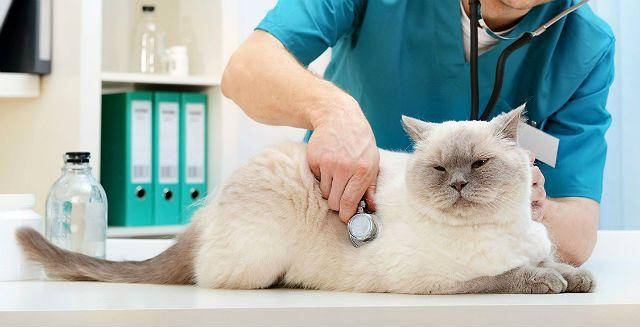
Prevention of urolithiasis in cats
Any prevention is aimed at preventing the disease or preventing a relapse. Preventive measures against urolithiasis are:
- Increased intake of clean water;
- Maintaining a normal pet weight;
- eating on a schedule (stable gastrointestinal function eliminates constipation);
- keeping the cat in a room with optimal air temperature;
- adherence to a diet depending on the type of deposits.
- the food should be varied and salt-free (seafood and fish often contain salts);
- it is better to choose food with a minimum of calories;
- vitamins must be taken, especially during the seasons of avitaminosis;
- If the cat eats ready-made food, the prevention of IBC in neutered cats will be the choice of mixes with appropriate labels ("for spayed cats", "for neutered cats", "for pets with IBC disease" etc.).
Important! Castration is a preventive measure of this disease only for females. Unspayed cats are at risk of IBC. And neutered cats, according to statistics, suffer from urolithiasis more often than non-castrated males.
Simple rules can help protect your pet from urolithiasis. If it is not possible to protect against it, it is important to notice the first signs in time and take the pet to the veterinarian.
Urolithiasis is a chronic disease, but relapses can be avoided with attention, care from owners and a special diet.
💡 A side note. You can always ask a veterinary nutritionist for help in making a balanced diet for your pet. You don't have to go anywhere at all. On Veterinarian Online you can get a consultation from a veterinary nutritionist at any time from the comfort of your home.






